As part of our new series covering all aspects of SEO, it's time to talk about on-page SEO.
In this article, you will learn what on-page SEO is, why all SEO professionals must master it, and the difference between on-page and off-page SEO. We will also talk about some of the critical elements of on-page SEO that you need to learn about.
What is On-Page SEO?
On-page SEO refers to any activity done to aid the practice of optimising individual web pages to improve their search engine visibility and keyword rankings on SERPs.
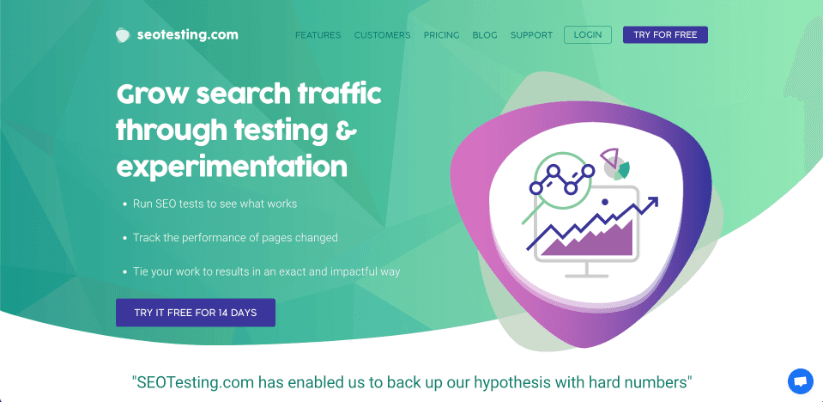
The primary goal of on-page SEO is to make a web page more relevant and appealing to users and search engine bots. Increasing the likelihood of the page ranking higher, getting more organic traffic and, hopefully, more conversions.
Why is On-Page SEO Important?
On-page SEO is essential as it directly impacts your website's search engine visibility and on-site user experience. By optimising various on-page elements (which we will talk about later), such as meta titles, content, headings, and images, a website can significantly improve its chances of ranking higher in the SERPs, especially for those "head" keywords that, in general, bring in the most traffic. Search engines, like Google, rely on this on-page information to understand the relevance and quality of a website, making it much easier for them to match your website to user queries.
Effective on-page SEO will also enhance the user experience on your website. When a web page is optimised with clear and well-structured content, users can find the information they are looking for quickly and easily. The proper use of headings, bullet points, and formatting makes content more readable for users. Optimising images (and other multimedia elements) also improves page loading speed, which is a crucial factor in reducing bounce rates. A positive user experience will not only encourage users to stay longer but may also increase the likelihood of social sharing and repeat engagement.
What is the Difference Between On-Page and Off-Page SEO?
On-page SEO and off-page SEO are two completely different strategies used in SEO campaigns to improve a website's visibility and ranking in search engine results pages. They focus on various aspects of a website and involve different techniques.
On-page SEO refers to the optimisation efforts implemented directly on a website's pages to improve user experience and search engine rankings. These optimisations are within the complete control of the website owner, marketing team and other administrators.
Off-page SEO involves everything done outside the website and generally includes building its credibility, authority and reputation across the internet. In most cases, off-page SEO consists of interacting with other websites and online platforms in some way, shape, or form.
On-page SEO will involve various website elements, including:
- Website content.
- Meta tags.
- Images.
- URL structure.
- Internal linking.
Off-page SEO will involve off-site elements, including:
- Link acquisition.
- Social media engagement.
- Brand mentions.
On-page SEO focuses on optimising your website's content, structure and elements, whilst off-page SEO involves activities that build your website's authority through external sources like backlinks and social media. Both on-page and off-page SEO are crucial parts of a comprehensive SEO strategy.
We will discuss various on-page SEO elements and how to improve them to help your site rank higher in search engines.
Site Speed
Site speed can often move the needle incredibly quickly regarding on-page SEO. In this section, we will discuss various elements that will impact your site speed and how they can be used to improve your website loading speed.
Use the Correct Hosting Solution
Selecting the right hosting solution for your website impacts how fast your site loads.
A quality hosting provider uses powerful servers to handle data quickly. For example, if the server is closer to your visitors, data moves faster. So, opting for a hosting solution with servers near your users is wise. Content delivery networks (CDNs) can help spread your content across multiple servers for faster delivery.
Having enough resources in your hosting plan is essential to handle traffic spikes smoothly. Reliable hosting providers can offer tools that automatically compress files and make the site load faster. The best hosting solutions also prioritise security which to minimise your site's downtime and keep it as safe as possible. A helpful support team can also assist with technical improvements to boost speed and overall performance. Choose the hosting solution that matches your site's needs for the best rate and user experience.
Compress and Optimise Images
Compressing and optimising images are vital in enhancing and improving site speed. When prints are correctly compressed, their file sizes are reduced without significantly compromising visual quality. In other words, users will still see clear images, but your website servers will be able to load a file quickly because it is smaller.
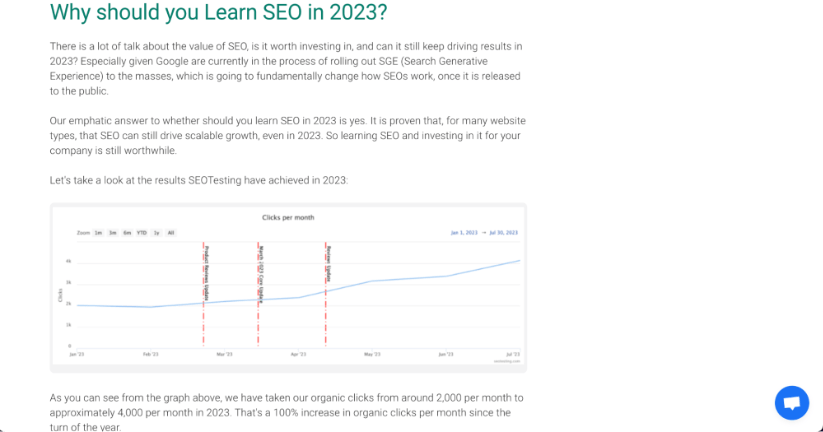
Large image files can slow down your website significantly because they require more time and bandwidth to load. When you compress images, you're essentially making them lighter, which leads to quicker download times. Faster download times mean your website's pages load quickly, improving the overall user experience.
Optimising images also involves choosing appropriate file formats for each image on your site. JPEG is great for photographs and images with gradients, whilst PNG files are better for images with transparency or sharp edges. Selecting the correct format ensures images are displayed at their best quality without unnecessarily bloating file sizes.
Optimising images also involves resizing them to fit the display area on your website. Uploading images that are larger than needed will waste bandwidth and loading time. By resizing images to match their intended display size, you reduce the amount of data that needs to be transferred. Resulting in a faster page load speed.
Pro tip: You can use a tool like TinyPNG to compress images with ease and improve your site speed.
Reduce the Use of Redirects
Reducing the use of redirects on a website will improve site speed by minimising the number of "round trips" between the user's web browser (for example, Google Chrome) and the server. When a user accesses a page with a redirect, the browser needs to make an additional request to the new URL. This results in a delay as the browser has to wait for your server's response. This adds to the overall page load time.
By minimising redirects, you eliminate these extra requests and reduce the time it takes for the browser to receive the resources required to load the page, resulting in a faster loading experience for the user.
Enable Browser Caching
When a user loads your website for the first time, their web browser must download all the elements needed to load the website effectively. This includes images, stylesheets and scripts. When browser caching is enabled, your website allows the user's browser to store this information so that it doesn't have to "start from scratch" the next time it loads your page.
By specifying how long resources should be cached, you control how often the browser needs to request new versions of those resources. Setting longer cache durations can further reduce load times for static resources that don't change frequently (like service pages). However, using cache control headers properly is essential to balance efficient caching and ensuring that users receive up-to-date content when needed.
Enabling browser caching reduces the need for repeated requests to the server for static resources, effectively minimising network traffic and latency. This results in faster page loads and a smoother user experience, particularly for users who frequently visit your site or navigate multiple pages.
Defer CSS and JavaScript Loading
Deferring the loading of CSS and JavaScript files is a smart move to make websites load faster. When people open a webpage, their browsers download and process the website's CSS and JavaScript files. But sometimes, this process slows everything down, especially with big files that need specific rendering.
The idea behind delaying these files is to prioritise showing the most important content and images before dealing with the fancy styling and interactive stuff. This way, the page starts looking good quickly, and users can immediately see meaningful content. This also solves the problem of specific files pausing the page's loading process, known as "render-blocking."
To make this happen, you can use the "async" or "defer" attributes in your <script> tags and also make sure your CSS is delivered smartly. "Async" makes scripts load in the background while the page is still being processed. "Defer" takes it a step further by loading scripts in the order they appear in the code and running them when the page's main parts are done being set up.
Minify HTML, CSS & JavaScript
Minifying CSS and JavaScript files can significantly improve site speed by reducing the size of these files, leading to faster load times and an improved user experience. When web developers write CSS and JavaScript, they often use descriptive variable names, comments and formatting to make the code more readable and easy to maintain. However, these elements are unnecessary for the browser to understand and execute the code. Minification involves removing all unnecessary whitespace comments and renaming variables to shorter names, effectively compressing the code.
The resulting minified files are smaller by eliminating extra characters and shortening variable names. Smaller files can be sent from the server to the browser faster, reducing latency and speeding up page load times. Additionally, when a user visits a website, their browser has to download and "parse" these files before rendering the page. Minified files require less parsing, which further contributes to faster loading times.
Mobile-Responsiveness
Since Google announced that mobile-responsive websites would receive a rankings boost against websites not optimised for mobile users, there has been a renewed importance on ensuring websites work on all devices.
This section will discuss some of the different things you can do to your website to ensure it is mobile-responsive.
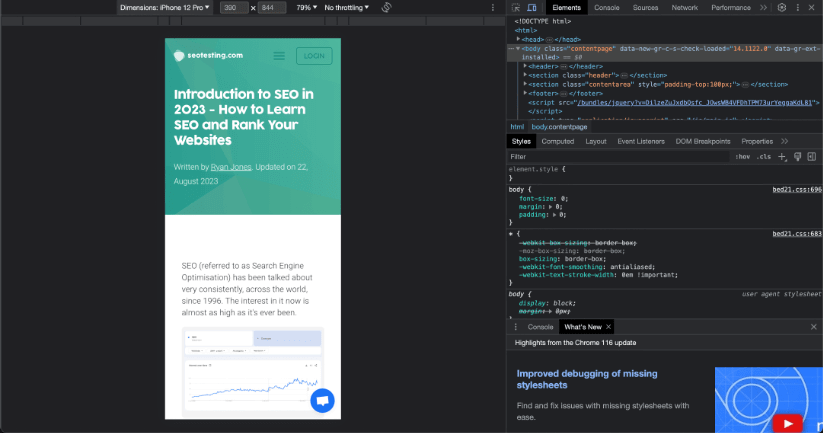
You can use Google Chrome's Developer Tools to see your website's appearance on a mobile device. Here, we are looking at our website on an iPhone 12 Pro screen.
Readability
Improving the readability of your website's content helps make your page more mobile-responsive in a few key ways.
Firstly, mobile devices have smaller screens than desktops, so content that is easy to read and well-structured ensures that users don't have to zoom in and out to understand the information. Clear fonts, appropriate text size, and ample spacing between lines and paragraphs make it easier for users to consume your content without straining their eyes or needing extra actions.
Secondly, well-organised and concise content allows for efficient use of limited screen space. Mobile devices have less room to display content (text or otherwise), so straightforward and clear wording ensures that important information is prioritised and presented well. Long paragraphs and complex sentences can be overwhelming, especially on mobile screens, whilst shorter paragraphs and bullet points make the text more "scannable," which will help users quickly understand your content.
Lastly, focusing on readability will encourage a mobile-first mindset in your web design and development. When prioritising readability, you're more likely to choose layouts, fonts, and formatting that naturally adapt to smaller screens. This includes using responsive design principles, like fluid grids and flexible images, which automatically adjust the layout depending on your screen size. By optimising readability for mobile, you're (essentially) tailoring your content for a more enjoyable and accessible experience. This will ultimately make your page more mobile-responsive.
Image Formatting
Formatting images and buttons will be vital in optimising your web page for mobile responsiveness.
You can ensure swift loading times and prevent unnecessary screen space consumption on smaller screens by resizing and optimising images to fit various screen sizes. This strategic approach to ideas prevents potential slowdowns during the page loading phase, preserving a good user experience. Employing images that adapt seamlessly and retain their aspect ratios across different devices maintains visual integrity while focusing on performance.
Secondly, thoughtfully adjusting your button formatting will enhance navigability on mobile devices. Ensuring buttons possess sufficient dimensions enables effortless tapping, minimising the risk of accidental taps on nearby elements. Implementing suitable spacing between buttons mitigates the likelihood of clicks in error. Using CSS to implement touch-sensitive styles, such as enlarging button size upon hover or tap, enriches interactivity for touchscreen users.
Harnessing the power of CSS media queries will allow you to tailor adjustments to image and button styles depending on the parameters of the user's screen. Media queries facilitate the creation of distinct types for specific screen sizes, guaranteeing easy adaptation of images and buttons to different devices. This customisation ensures that images and buttons remain seamless and visually pleasing across the vast spectrum of mobile-responsive contexts.
Content Writing
We will move on to one of the biggest things you have control over regarding on-page SEO. The content you write.
Your content impacts your appearance in the SERPs and how highly you rank for different queries. You have complete control over this, so we will go over the key things you can do during your content writing process to help your on-page SEO.
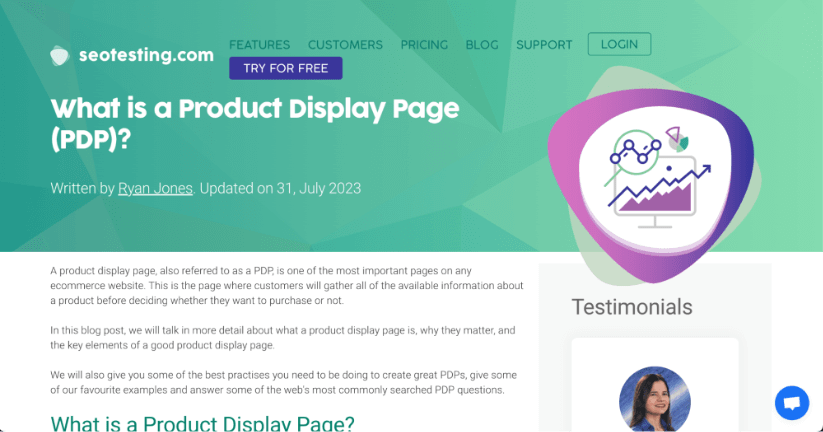
Keyword / Query Research
Effective keyword and query research is crucial for on-site SEO improvements. Your research will impact content strategy, site optimisation and your user experience.
Firstly, by identifying important keywords and phrases, you can craft valuable content that resonates with your target audience, which will help bolster your website's authority and ranking in the SERPs.
Secondly, optimising on-site elements like titles, meta descriptions, and headers with these keywords will (in many cases) directly enhance your visibility in search results. We know that placing keywords into these elements gives your website a better chance. We and some of our customers have tested this, which led to an increase in traffic;and you can test this yourself too! The alignment between user intent and your website's content enhances user experience, leading to higher engagement and conversions.
Proper keyword research will help underpin a holistic approach to on-site SEO. This will elevate your content quality, site visibility and overall user satisfaction!
Write Quality & Helpful Content
Creating high-quality and helpful content will significantly enhance your on-site SEO by providing value to your audience and aligning with Google's ranking algorithms, including algorithm updates like the "Helpful Content Updates" we have seen since the end of 2021.
Producing content that addresses your audience's questions, concerns and interests will establish your website as a reliable and credible source within your niche. This encourages users to spend more time on your website, reducing bounce rates and signalling that your content is relevant and engaging to search engines. Google's recent algorithm updates, especially the Helpful Content Updates, focus on understanding user intent and context, rewarding sites that offer comprehensive and valuable information.
Secondly, high-quality content tends to attract more backlinks (organically) than content that is not helpful to the user. Backlinks are crucial for improving your website's authority in the eyes of search engines. When reputable websites link to your content, it signals to search engines that it is trustworthy and relevant, positively influencing your rankings.
Google's algorithms have become increasingly more intelligent and can now more effectively assess the quality of your content. They now consider factors such as readability, depth of information, and user engagement metrics. By focusing on these elements with your content, you can ensure that your content aligns with Google's vast ranking criteria and has a better chance of ranking and bringing in organic traffic.
Consistently producing high-quality content attracts organic traffic and encourages users to share your content, expanding your reach and authority.
Ensure your Content Matches Search Intent
We will only spend a little time on this particular section, as this should be self-explanatory.
Writing content that entirely matches search intent is crucial for your on-site SEO. This is because it ensures that your content directly addresses what users are searching for.
When your content aligns with their specific queries and provides relevant information, search engines can effectively recognise its value and relevance, leading to higher rankings and improved user engagement and experience.
Content Optimisation
It's not just new content you are writing that impacts your on-site SEO; it's also existing content that you are optimising! This section will discuss different content optimisation methods and how they help improve your on-page SEO.
URL Optimisation
Optimising your URLs is a vital part of boosting your on-page SEO. When you include relevant keywords in your URLs, search engines quickly grasp what your page is about, increasing the chances of your content appearing in searches. Additionally, user-friendly URLs give visitors a clear picture of your page's content before they click on your site! This will reduce bounce rates and make them more likely to explore further.

Readable and "shareable" URLs are essential for sharing on social media or other websites, as they are easier for users and algorithms to understand. This can lead to more clicks, shares and even backlinks! Moreover, a well-structured URL can help prevent problems with duplicate content and aids search engine bots in efficiently crawling and indexing your pages. This ensures your content is accurately represented in search results.
By optimising your URLs to be clear, relevant and user-friendly, you not only improve your site's visibility in search engines but also provide a smoother experience for your audience. This simple practice contributes to higher engagement, better search rankings and a solid foundation for your on-page SEO efforts.
Heading Optimisation
Heading information will help your on-page SEO in almost the same way as URL optimisation.
By making your headings clear, simple and easy to understand, you will help both search engines and users understand what your content is about, making it more likely for your content to rank higher and see more social shares.
Ross Hudgens, CEO of Siege Media, has said this about heading structure:
"Want to rank better? Make your post structure simple.
Whether correlative or causative, we consistently see simple post structures ranking well.
These structures make it easy for users to pull out the answers they want instead of having to dig for them."
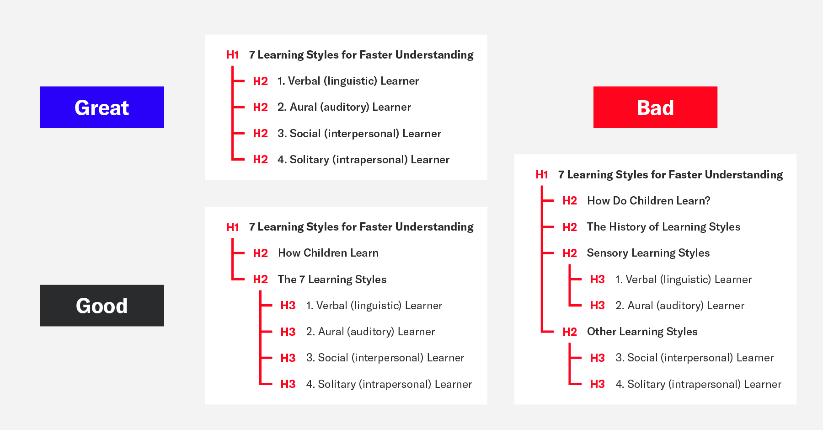
Keywords in Copy
Adding keywords to your content improves your on-page SEO by helping search engines understand what your content is about. By including relevant keywords (naturally) in your content, you are signalling to search engines that your page applies to those specific topics. This increases the chances of your web page ranking well in search results when someone searches for those keywords or queries.
However, it's essential to use keywords in a way that sounds natural and fits well within the context of your content, as search engines also consider the quality and readability of your content.
Remember, whilst keywords are essential, focussing on providing valuable and informative content for your visitors should be your top priority! Balancing keyword usage with high-quality content will improve your on-page SEO and create a better overall experience for the users on your site.
Internal & External Links
Links on your website are critical. We all know this. But it's not just internal links that impact your on-page SEO. It's also your external or outbound links. These links have an impact, too.
Internal links act as signposts within your website, guiding visitors and search engine bots to different pages. They connect one page of your site to another.
These links are essential for on-page SEO because they help search engine crawlers understand the structure of your site and the relationships between your pages. When you link from one page to another on your site, you tell search engines that the linked page is relevant and valuable. This can improve the overall visibility of your content in search engine results. Internal links can also keep visitors engaged by offering them more related content to explore, increasing their time on your site.
Remember, though, it's essential to use descriptive anchor text that provides a clear idea of what the linked page is about.
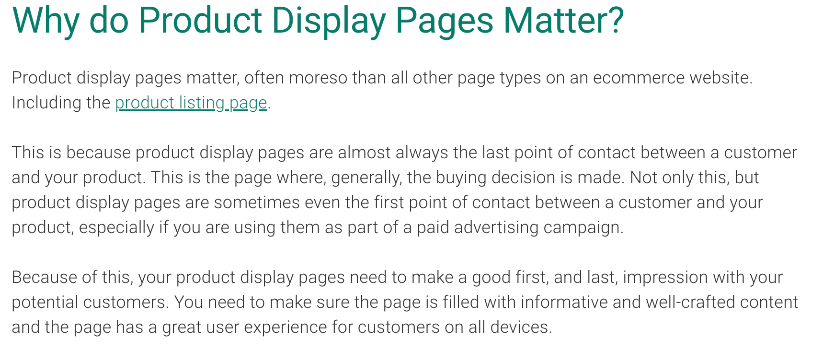
External links are links from your website to another unrelated website. These links are also crucial for your on-page SEO as they add a layer of credibility and context to your content.
When you link to reputable and relevant external sources, you show search engines and users that you have done your research and that your content is well-supported. This can enhance your content's authority and trustworthiness in the eyes of the search engines and the users you have on your page. External links also help search engines understand the broader web ecosystem and how your content fits it!
Just be sure to link to high-quality, relevant sources that enhance the user experience. Excessive or irrelevant external linking can harm your SEO efforts.
Meta Information
Meta information, such as meta titles and descriptions, goes a long way to improving your on-page SEO. In this section, we'll discuss some of the critical things you need to do with your meta information to give your site the best chance of success in the SERPs.
Short Meta Titles
Short meta titles will play a helpful role in improving your on-site SEO by providing concise but relevant information about the content of a web page.
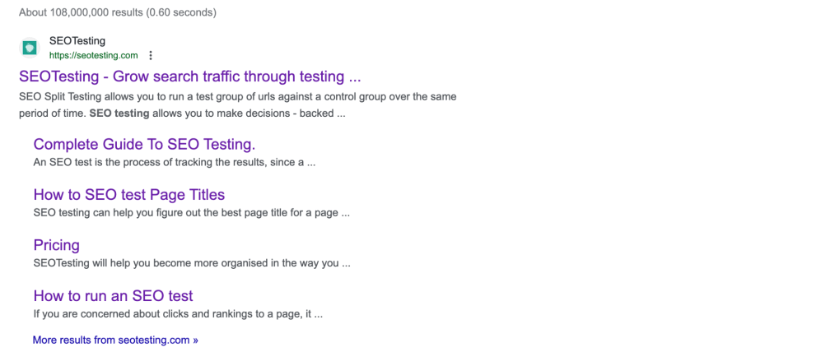
Keeping meta titles short is essential because search engines typically only display a limited number of characters in their search results. By crafting a concise and informative title, you're more likely to capture the users' attention and entice them to click on your link over competitor sites. Short meta titles are more accessible for users to read and for search engines to interpret and understand, as they can quickly identify the main topic and focus of the page.
Keyword Included within Meta Title & Description
Including the main targeted keyword in your meta title and description directly impacts your on-page SEO by improving relevancy and increasing the likelihood of attracting clicks from search engine users.
By including your main keyword in both elements, you signal to users and search engines that your page is relevant to the search query. This will increase the chances of your page being displayed in search results when users search for that keyword or query.
When the keyword appears in the meta title and description, users are likelier to click on your link because they can see that your content will most likely align with what they're looking for. This higher click-through rate sends a positive signal to search engines that your page is valuable and meets user's needs. This will potentially lead to improved rankings over time.
Experiment with 'Modifiers'
Modifiers are words you can add to your meta tags, such as titles or descriptions, to create more specific and diverse variations of your content's focus. Modifier terms include:
- Best
- Tips
- Guide
- Review
- Top
- How To
- Complete
Experimenting with these modifiers helps your on-page SEO by expanding your reach to different search queries that users might enter in search engines. When you incorporate a variety of modifiers related to your main content, you increase the likelihood of your content appearing in search results for those variations. This broadens your visibility and improves the chances of attracting users looking for specific aspects or types of content related to your topic.
You can tap into long-tail keywords by using modifiers strategically in your meta tags. This can result in better-targeted traffic to your site, even if the search volume is lower.
For example, if your main keyword is "digital cameras", adding a modifier like "best digital cameras for beginners" tailors your content to a specific audience segment. Users searching for this long-tail keyword are more likely to find your content relevant, leading to higher engagement and potentially better conversion rates.
Bonus: Title Tag Testing
Title tag testing is essential to on-page SEO optimisation that can significantly enhance your website's search engine visibility.
By utilising tools like SEOTesting, you can systematically experiment with different title tags to evaluate their impact on your:
- Search engine rankings.
- Organic clicks.
- Organic impressions.
- Click-through rate.
This process allows you to identify high-performing title tags that align better with user intent and relevant keywords. As a result, your website can achieve better organic traffic numbers as search engines better understand the content of your pages, and users are more likely to click through due to compelling and relevant titles.
Continuous title tag testing will ensure that your on-page SEO efforts remain adaptable and effective in keeping up with search engine algorithm updates and changes in user preferences.
Here's an example of a customer title tag test that significantly improved their "SEO metrics" for the page in question:
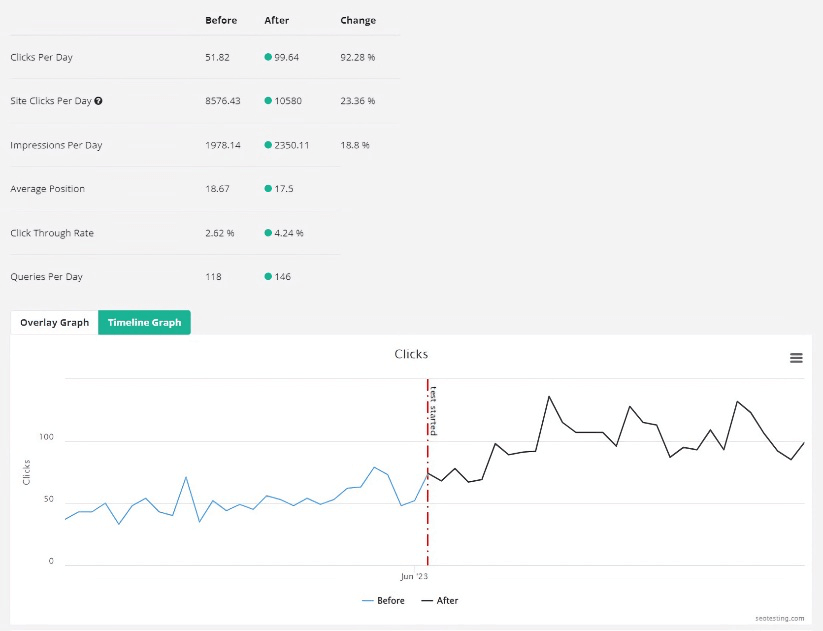
This customer added two words (we cannot share what two terms, as it is a customer test) to their meta title and page H1. As you can see, the results were tremendous for their page:
- 92% increase in clicks per day to the page.
- 18% increase in impressions per day to the page.
- The average position jumped from 18 to 17.
- Click through rate jumped from 2.62% to 4.24%.
Mastering on-page SEO is essential for improving search engine visibility and user experience on your page. Optimising elements like your meta information, content quality, internal & external links, and mobile responsiveness will, in many cases, enhance rankings, engagement and conversions.
Effective on-page SEO involves a lot of keyword research, quality content creation, URL optimisation and the strategic use of headings and modifiers.
Like title tag testing, regular testing ensures better adaptability to changing algorithms and user preferences, ultimately driving higher organic traffic and better search rankings overall.
If you want to implement an SEO testing strategy within your overall SEO efforts, look no further than SEOTesting. We offer a 14-day free trial with no credit card required for sign-up. Give it a try today.

